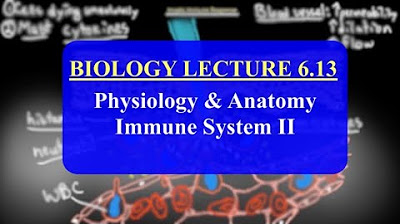Immunology Map - Immune Cells
Summary
TLDRThis educational video series, titled 'Immunology Map,' delves into the immune system's intricacies, focusing on the origin and journey of immune cells. Stemming from bone marrow stem cells, these cells mature in various tissues, exemplified by T-cells in the thymus and B-cells in lymph nodes. The series distinguishes between innate and adaptive immune cells, highlighting key players like neutrophils, macrophages, and dendritic cells. It also touches on natural killer cells and their unique ability to identify and eliminate abnormal cells without external signals.
Takeaways
- 🌟 The video series focuses on the immune system and lymphatic system, termed the 'Immunology Map'.
- 🔬 The immune cells originate from stem cells in the bone marrow, which differentiate into various types of white blood cells.
- 📍 Stem cells in the bone marrow produce precursor cells that migrate to different tissues for maturation and activation.
- 💧 The bone marrow contains hematopoietic stem cells that give rise to both the innate and adaptive immune cells, as well as red blood cells.
- 🚦 Myoid progenitor cells from the bone marrow produce innate immune cells like granulocytes, mast cells, and macrophages.
- 🔄 Granulocytes include basophils, eosinophils, and neutrophils, each with specific roles in immune response.
- 🔬 Lymphoid progenitor cells give rise to cells of the adaptive immune system, including T-cells and B-cells.
- 🛡️ T-cells mature in the thymus and play a critical role in cell-mediated immunity, while B-cells mature in the lymph nodes and produce antibodies.
- 🔀 Dendritic cells act as a bridge between the innate and adaptive immune systems by presenting antigens to T-cells.
- ⚔️ Natural killer (NK) cells are large granular cells that can kill abnormal cells, such as tumor cells or cells infected by viruses, without prior activation.
- 🔄 The video script also mentions the process of maturation and activation of immune cells in different tissues and organs.
Q & A
What are the two main types of progenitor cells that stem cells give rise to?
-The two main types of progenitor cells that stem cells give rise to are the lymphoid progenitor cell and the myeloid progenitor cell.
What is the primary function of the lymphoid progenitor cell?
-The primary function of the lymphoid progenitor cell is to give rise to cells that are part of the Adaptive immune system.
How does the myeloid progenitor cell contribute to the innate immune system?
-The myeloid progenitor cell gives rise to immune cells that are part of the innate immune system, such as granulocytes and monocytes.
What is the role of the erythroblast in the body?
-The erythroblast eventually matures into a red blood cell (erythrocyte), which is crucial for transporting oxygen to different tissues and removing carbon dioxide from the body.
What are the main functions of platelets produced by megakaryocytes?
-Platelets play a critical role in initiating hemostasis and repairing tissues.
How do granulocytes get their name, and what are the three types of granulocytes produced in the bone marrow?
-Granulocytes get their name because they contain granules. The three types of granulocytes produced in the bone marrow are basophils, eosinophils, and neutrophils.
What is the primary function of basophils in the immune system?
-Basophils promote allergic responses and are important for defense against parasites.
What is the role of neutrophils when they enter the bloodstream?
-Neutrophils are the fast-acting cells that go to the site of inflammation or damage the quickest and are the most abundant white blood cells.
How do mast cells differ from other granulocytes?
-Mast cells differ from other granulocytes because they do not circulate like basophils and neutrophils; instead, they stay in the tissue.
What is the primary function of monocytes and their derivative, the macrophage?
-Monocytes circulate in the bloodstream and, upon entering tissues, become macrophages, which are antigen-presenting cells that also engulf pathogens.
What is the role of immature dendritic cells in the immune system?
-Immature dendritic cells play a crucial role as they connect the innate and adaptive immune systems by entering tissues, taking up antigens, and presenting them to adaptive immune cells.
How do natural killer cells differ from other immune cells?
-Natural killer cells are unique because they can kill abnormal or infected cells naturally without the need for signals from other cells.
Outlines

Cette section est réservée aux utilisateurs payants. Améliorez votre compte pour accéder à cette section.
Améliorer maintenantMindmap

Cette section est réservée aux utilisateurs payants. Améliorez votre compte pour accéder à cette section.
Améliorer maintenantKeywords

Cette section est réservée aux utilisateurs payants. Améliorez votre compte pour accéder à cette section.
Améliorer maintenantHighlights

Cette section est réservée aux utilisateurs payants. Améliorez votre compte pour accéder à cette section.
Améliorer maintenantTranscripts

Cette section est réservée aux utilisateurs payants. Améliorez votre compte pour accéder à cette section.
Améliorer maintenantVoir Plus de Vidéos Connexes

Fisiologi Proses Inflamasi | Physiology Video Eps. 10

Activación y Diferenciación de Linfocitos T | Sinapsis Inmunológica - Subgrupos de Linfocitos T

Aula: Imunologia - Sistema Complemento | Imunologia #8

IMAT Biology Lesson 6.13 | Anatomy and Physiology | Immune System Part II

Humoral Immunity | The B-Lymphocytes | Immunology | Physiology

Cell-Mediated (Cellular) Immunity [aka T-cell immunity] - Physiology & Immunology
5.0 / 5 (0 votes)
